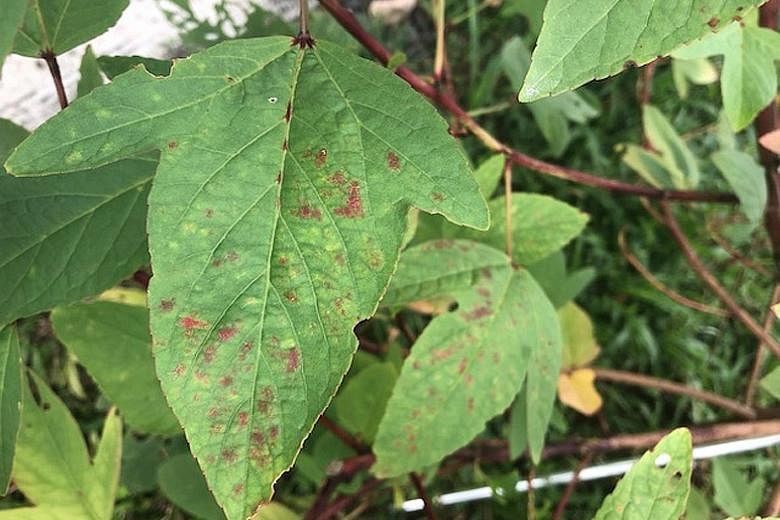Mealy bugs on roselle
My roselle plant seems to be badly infested. There are white mites (far right), red patches on the leaves (right), spiders and ants around it. I have been spraying the plant with a sulphur water mixture and removing the white mites manually. What else should I do?
Goh Chew Eng
The white mites are mealy bugs. You can use sulphur soap to treat it and rotate it with other environment-friendly pesticides like neem oil and summer oil. As these are contact insecticides, you need to ensure you spray all parts of the plant to suffocate any adult and young pests present on the plant.
Repeated applications based on the frequency recommended by the manufacturer are often required to ensure the pest population remains low.
The reddish patches on the leaves may be a response to something being sprayed on them. Did you apply any fertiliser or chemical on the leaves recently?
If they appear on the older leaves of the plant, it could also mean that your plant is suffering from a nutrient deficiency.
Ensure that the soil pH level is optimal for the plant and improve the soil conditions by incorporating good quality organic matter into the root zone. This will ensure nutrients are not locked up and promote healthy root growth.

Sugarcane infested by sucking scale insects
My sugarcane is growing quite well. But lately, the leaves have started to turn black at the tips, as if covered in soot, which can be removed by rubbing the leaves. There are yellowish dots at the base of the leaves (right) that look like worms. Is my plant diseased?
Thomas Lee Chee Chee
Your sugarcane is affected by a sucking insect - likely a type of scale insect. The pest excretes a sugar-rich solution, which brings about sooty mould that appears on the surface of the leaves.
As your sugarcane is for consumption, you may want to resort to less toxic pest-control methods.
First, wash the pests off the plant with a strong jet of water to reduce the number of pests to deal with.
Then spray a dilute solution of neem oil or summer oil weekly to keep the pest population in check. As these pesticides work via the contact mode, you will have to ensure that you cover all surfaces of the plant when you are spraying the pesticide solution.

Blue pea plant has spider mite infestation
What is wrong with the leaves of my blue pea plant?
Rose Tang
Your blue pea plant (Clitoria ternatea) has a spider mite infestation, which is common in this plant. The pests appear as small red dots on the underside of leaves.
If your plant is robust, you may want to remove the infested leaves. Spray a dilute solution of neem oil or summer oil during the cooler part of the day to kill any remaining adult mites found on the plant.
When new leaves emerge, you may want to consider spraying the foliage daily with water to wash off mites and apply the above treatment weekly to keep the pest population low to not cause any visible damage.
Finally, ensure that the growing area is humid and that the plant receives sufficient sunlight. You may need to selectively prune the excessive leaves that the plant produces.

Common Mugwort used in traditional Chinese medicine
My neighbour gave me this plant (above) and said it can be eaten. Is this true?
Low Meow Eel
Botanically known as Artemisia vulgaris, the plant's common names include "Ai Ye" (Chinese name in hanyu pinyin), Common Mugwort, Common Wormwood and Moxa.
It is a common medicinal plant and used in traditional Chinese medicine to improve blood circulation and gynaecological issues.
The fresh leaves are known to be bitter, but can be used as a flavouring herb. They can be added to fried eggs or made into dumplings.

Common Tree-Vine can be propagated by stem-cuttings or seeds
I have been told the leaves of this plant (right) have medical properties. What is the name of this plant? How do I get rid of insects attacking the leaves and propagate the plant?
Christine Chui
The plant is a native plant of Singapore.
It is botanically known as Leea indica and its common names include Common Tree-Vine, Jolok-Jolok and Merbati Padang.
This plant can be propagated via stem-cuttings or seeds that are produced when it grows larger and begins to flower and fruit.
There are small chewed marks on the leaves that could be caused by beetles.
A few chewed marks are usually no reason for concern.
If you are using the plant for medicinal purposes, you may want to use a less toxic pesticide such as neem oil, which can deter pests from eating your plant.
You can construct a fine netted tent over the plant to protect it from pests.
• Answers by Dr Wilson Wong, an NParks-certified practising horticulturist and park manager. He is the founder of Green Culture Singapore and an adjunct assistant professor (Food Science & Technology) at the National University of Singapore.
• Have a gardening query? E-mail it with clear, high-resolution pictures of at least 1MB, if any, and your full name to stlife@sph.com.sg


